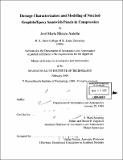| dc.contributor.advisor | S. Mark Spearing. | en_US |
| dc.contributor.author | Mirazo Antolín, José María, 1975- | en_US |
| dc.date.accessioned | 2010-01-07T20:48:42Z | |
| dc.date.available | 2010-01-07T20:48:42Z | |
| dc.date.copyright | 1999 | en_US |
| dc.date.issued | 1999 | en_US |
| dc.identifier.uri | http://hdl.handle.net/1721.1/50521 | |
| dc.description | Thesis (S.M.)--Massachusetts Institute of Technology, Dept. of Aeronautics and Astronautics, 1999. | en_US |
| dc.description | Includes bibliographical references (leaves 129-133). | en_US |
| dc.description.abstract | Damage tolerant design, which focuses on a structure's ability to perform in a damaged state, is widely used in the aerospace industry today. Although extensive research has been carried out in this area for notched composite laminates, a relatively small fraction has dealt with compressive loading of composite honeycomb sandwich panels. Furthermore, little emphasis has been placed on identifying and modeling the damage mechanisms that contribute to ultimate failure. In an attempt to better understand the damage propagation and residual properties of notched composite panels subjected to compressive loads, edge-wise uniaxial quasi-static tests were performed in displacement control. Coupons consisted of various sized notched sandwich panels with woven Graphite-reinforced PMC facesheets and Nomex honeycomb cores. Two lay-ups were used in the facesheets: [45/0/0] and [0/0/0/], identified as T45 and TO respectively for simplicity. Damage propagated in all coupons perpendicular to the load direction from one or more of the four notch tips. All coupons were loaded to final failure. In-situ and post-mortem damage evaluation techniques such as polishing and microscopy were employed to describe the damage progression. The key microscopic damage mechanisms were identified to be delamination and fiber micro-buckling, which often led to kinkband formation. Two distinct failure types were identified macroscopically: linear damage zones (LDZ's) and delamination/bulge zones (DBZ's), the latter being confined to the T45 series. The LDZ's consisted of out-of-plane kink-bands propagating away from the notch in the 00 plies, and were modeled using a bridged-crack analogy with tensile loading (DZM). The DBZ's were formed by the outer 450 ply, which delaminated from the rest of the coupon and buckled locally into a deformed out-of-plane curved shape. They were described using a novel one-dimensional delamination/buckling propagation model (DBM). Comparison between the two models revealed that smaller panels were more prone to linear damage zone formation, whereas larger panels were more prone to delamination/buckling zone formation. Damage mechanism charts were produced which are capable of predicting the operative damage mechanism as a function of material and geometric parameters. | en_US |
| dc.description.statementofresponsibility | by José María Mirazo Antolín. | en_US |
| dc.format.extent | 146 leaves | en_US |
| dc.language.iso | eng | en_US |
| dc.publisher | Massachusetts Institute of Technology | en_US |
| dc.rights | M.I.T. theses are protected by
copyright. They may be viewed from this source for any purpose, but
reproduction or distribution in any format is prohibited without written
permission. See provided URL for inquiries about permission. | en_US |
| dc.rights.uri | http://dspace.mit.edu/handle/1721.1/7582 | en_US |
| dc.subject | Aeronautics and Astronautics | en_US |
| dc.title | Damage characterization and modeling of notched graphite/epoxy sandwich panels in compression | en_US |
| dc.type | Thesis | en_US |
| dc.description.degree | S.M. | en_US |
| dc.contributor.department | Massachusetts Institute of Technology. Department of Aeronautics and Astronautics | en_US |
| dc.identifier.oclc | 42695802 | en_US |
